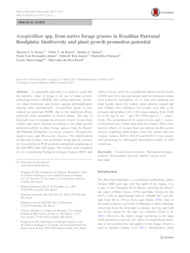Azospirillum spp. from native forage grasses in Brazilian Pantanal floodplain: biodiversity and plant growth promotion potential.
Azospirillum spp. from native forage grasses in Brazilian Pantanal floodplain: biodiversity and plant growth promotion potential.
Author(s): SOUZA, M. S. T.; BAURA, V. A. de; SANTOS, S. A.; FERNANDES JUNIOR, P. I.; REIS JUNIOR, F. B. dos; MARQUES, M. R.; PAGGI, G. M.; BRASIL, M. da S.
Summary: A sustainable alternative to improve yield and the nutritive value of forage is the use of plant growth promoting bacteria (PGPB) that release nutrients, synthesize plant hormones and protect against phytopathogens (among other mechanisms). Azospirillum genus is considered an important PGPB, due to the beneficial effects observed when inoculated in several plants. The aim of this study was to evaluate the diversity of new Azospirillum isolates and select bacteria according to the plant growth promotion ability in three forage species from the Brazilian Pantanal floodplain: Axonopus purpusii, Hymenachne amplexicaulis and Mesosetum chaseae. The identification of bacterial isolates was performed using specific primers for Azospirillum in PCR reactions and partial sequencing of the 16S rRNA and nifH genes. The isolates were evaluated in vitro considering biological nitrogen fixation (BNF) and indole-3-acetic acid (IAA) production. Based on the results of BNF and IAA, selected isolates and two reference strains were tested by inoculation. At 31 days after planting the plant height, shoot dry matter, shoot protein content and root volume were evaluated. All isolates were able to fix nitrogen and produce IAA, with values ranging from 25.86 to 51.26 mg N mL?1 and 107?1038 ?mol L?1, respectively. The inoculation of H. amplexicaulis and A. purpusii increased root volume and shoot dry matter. There were positive effects of Azospirillum inoculation on Mesosetum chaseae regarding plant height, shoot dry matter and root volume. Isolates MAY1, MAY3 and MAY12 were considered promising for subsequent inoculation studies in field conditions.
Publication year: 2017
Types of publication: Journal article
Unit: Embrapa Semi-arid Region
Observation
Some of Embrapa's publications are published as ePub files. To read them, use or download one of the following free software options to your computer or mobile device. Android: Google Play Books; IOS: iBooks; Windows and Linux: Calibre.
Access other publications
Access the Agricultural Research Database (BDPA) to consult Embrapa's full library collection and records.
Visit Embrapa Bookstore to purchase books and other publications sold by Embrapa.

